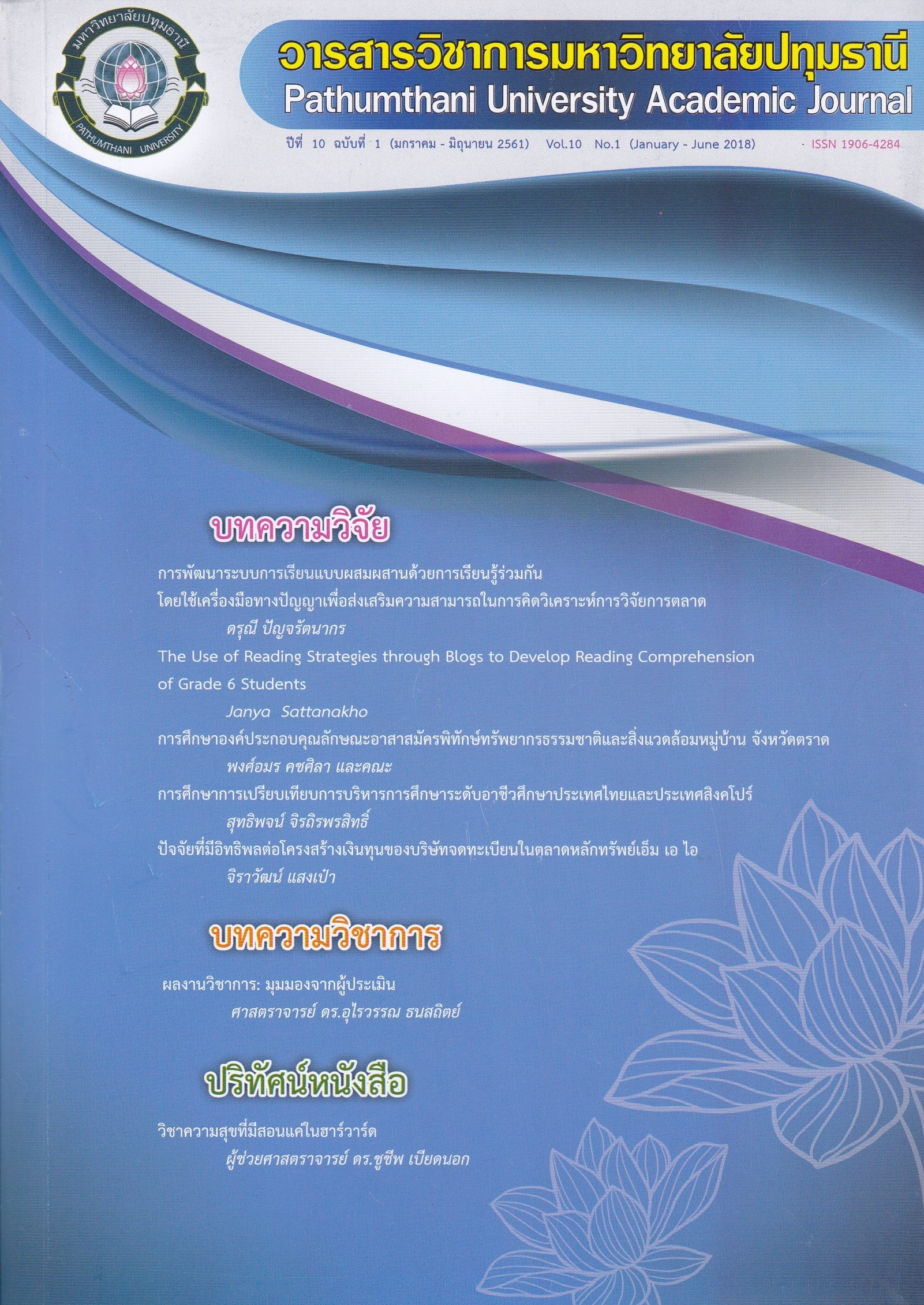Participation Processes in Lifelong Education: Case Study at Surin Vocational Training and Development Center for Thai People Along the Border Areas
Keywords:
การมีส่วนร่วม, การศึกษาตลอดชีวิตAbstract
This research has as its objective to compare community participation processes in lifelong education: Case study at Surin Vocational Training and Development Centre for Thai People along the Border Areas once the raw data of genders, age, educational levels, career, population were separated from 132 Professional Training Communities and the improvement of Thai People along the Border Areas. The instruments used was interview method that shows the correlation coefficient was at 0.80 - 1.00 and confidence was at 0.871. The statistics used for data analysis were t-test and F-test. The study revealed that: 1) The community participation process in lifelong education and the status of community members separated by genders had the statistically significant value at 0.05, 2) Community participation in lifelong education and status of community members separated by level of education had a little different of statistically significant value at the 0.05, 3) The difference mean of the community participation process in lifelong education and the status of community members separated by age, found that age group of 18-30 years has the participation process in lifelong education and participates in more than the 41-50 year-olds and 51-60 year-olds while other age ranks showed no different statistically significant, and 4) The results of the difference in mean of the community participation process in lifelong education and the status of the community members found that the groups of government officers / employees of private organizations had higher participation rate than those with agricultural occupations and business owners and for those with casual jobs had a little different in statistically significant.
References
2. ฉัตยาพร เสมอใจ. (2550). พฤติกรรมผู้บริโภค. กรุงเทพ : ซีเอ็ดยูเคชั่น.
3. ธีระภัทรา เอกผาชัยสวัสดิ์. (2554). ชุมชนศึกษา. พิมพ์ครั้งที่ 2. กรุงเทพ : จุฬาลงกรณ์มหาวิทยาลัย.
4. พระครูเกษมสุทธิคุณ (แสงมณี รัตนากร). (2553). กระบวนการมีส่วนร่วมระหว่างบ้าน วัด โรงเรียน (บวร) ต่อการพัฒนาโรงเรียนวิถีพุทธ เขตลาดกระบัง สังกัดสำนักงานเขตพื้นที่การศึกษาประถมศึกษา กรุงเทพมหานคร. วิทยานิพนธ์ปริญญาพุทธศาสตรมหาบัณฑิต สาขาวิชาการบริหารการศึกษา. มหาวิทยาลัยมหาจุฬาลงกรณราชวิทยาลัย.
5. ศูนย์ฝึกและพัฒนาอาชีพราษฎรไทยบริเวณชายแดนไทยสุรินทร์. (2559). ยุทธศาสตร์และจุดเน้น การดำเนินงานศูนย์ฝึกและพัฒนาอาชีพราษฎรไทยบริเวณชายแดนสุรินทร์ ประจำปีงบประมาณ 2559. สุรินทร์ : ศูนย์ฝึกและพัฒนาอาชีพราษฎรไทยบริเวณชายแดนไทย สุรินทร์.
6. สำนักงานคณะกรรมการการศึกษาแห่งชาติ. (2543). ยุทธศาสตร์การศึกษาตลอดชีวิตเพื่อสังคมไทยในศตวรรษที่ 21. กรุงเทพฯ : สถาบันเทคโนโลยีเพื่อการศึกษาแห่งชาติ.
7. สุภาวดี วาทิกทินกร. [ออนไลน์]. (2552). การวิจัยและพัฒนา : กระบวนการเรียนรู้ตลอดชีวิต. เข้าถึงเมื่อ 10 ธันวาคม 2559. เข้าถึงได้จาก https://panchalee.wordpress.com
Downloads
Published
How to Cite
Issue
Section
License
บทความที่ได้รับการตีพิมพ์เป็นลิขสิทธิ์ของวารสารมหาวิทยาลัยปทุมธานี
ข้อความที่ปรากฎในบทความแต่ละเรื่อง เป็นความคิดเห็นส่วนตัวของผู้เขียน กองบรรณาธิการไม่จำเป็นต้องเห็นด้วยเสมอไป และไม่มีส่วนรับผิดชอบใด ๆ ถือเป็นความรับผิดชอบของผู้เขียนแต่เพียงผู้เดียว



